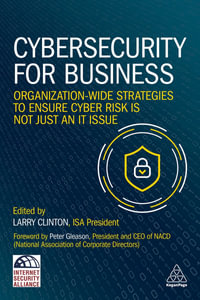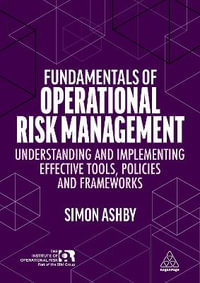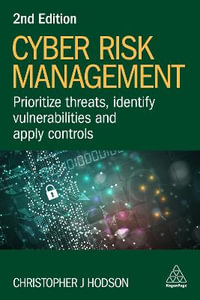
Manager's Guide to Enterprise Security Risk Management
Essentials of Risk-Based Security
By: Brian Allen, Rachelle Loyear, Kristen Noakes-Fry (Editor)
Paperback | 15 May 2018
At a Glance
148 Pages
27.94 x 21.59 x 0.81
Paperback
$54.59
or 4 interest-free payments of $13.65 with
orAims to ship in 7 to 10 business days
Is security management changing so fast that you can’t keep up? Perhaps it seems like those traditional “best practices” in security no longer work? One answer might be that you need better best practices! In their new book, The Manager’s Guide to Enterprise Security Risk Management: Essentials of Risk-Based Security, two experienced professionals introduce ESRM. Their practical, organization-wide, integrated approach redefines the securing of an organization’s people and assets from being task-based to being risk-based.
In their careers, the authors, Brian Allen and Rachelle Loyear, have been instrumental in successfully reorganizing the way security is handled in major corporations. In this ground-breaking book, the authors begin by defining Enterprise Security Risk Management (ESRM):
“Enterprise security risk management is the application of fundamental risk principles to manage all security risks − whether information, cyber, physical security, asset management, or business continuity − in a comprehensive, holistic, all-encompassing approach.”
In the face of a continually evolving and increasingly risky global security landscape, this book takes you through the steps of putting ESRM into practice enterprise-wide, and helps you to:
Differentiate between traditional, task-based management and strategic, risk-based management.
See how adopting ESRM can lead to a more successful security program overall and enhance your own career.
Prepare your security organization to adopt an ESRM methodology.
Analyze and communicate risks and their root causes to all appropriate parties.
Identify what elements are necessary for long-term success of your ESRM program.
Ensure the proper governance of the security function in your enterprise.
Explain the value of security and ESRM to executives using useful metrics and reports.
Throughout the book, the authors provide a wealth of real-world case studies from a wide range of businesses and industries to help you overcome any blocks to acceptance as you design and roll out a new ESRM-based security program for your own workplace.
Industry Reviews
Book Review: The Manager’s Guide to Enterprise Security Risk Management: Essentials of Risk-Based Security.
10 March 2018 by Brian J. Allen, CPP, and Rachelle Loyear. Reviewed by Rachid Kerkab
Appears In March 2018 Print Issue Security Management, a Publication of ASIS International
âRothstein Publishing; Rothstein.com; ebook.
The security landscape is evolving at an enormous speed. Volatility, uncertainty, complexity, and ambiguity are the new normal. So, how do you address security challenges in such an environment? The answer is through enterprise security risk management (ESRM), an integrated risk-based approach to managing security risks. It brings together cyber, information, physical security, asset management, and business continuity. ASIS has made ESRM a global strategic priority.
In the Manager’s Guide to Enterprise Security Risk Management, authors Allen and Loyear provide a comprehensive overview of the principles and applications underlying the ESRM philosophy. They set the stage in the first part of the book with an introduction to ESRM and share some important insights on the differences between traditional security and the ESRM approach, illustrating their points with examples.
The second part of the book guides the reader through the implementation of an ESRM program. One excellent chapter promotes design thinking as a conceptual model for ESRM. A design thinking approach can provide a unique platform for innovation and overcoming new security challenges.
Finally, the book provides insights and strategies to ensure the success of the ESRM program. It explains what an executive needs to know about ESRM, and gives readers the tools to succeed.
In sum, this guide accomplishes exactly what it set out to do—provide security leaders and managers with the principles and applications to explore, design, implement, and secure the success of an ESRM program.
Note: The authors of this book recently published a more detailed look at ESRM in Enterprise Security Risk Management: Concepts and Applications, also published by Rothstein Publishing.
Reviewer: Rachid Kerkab has almost two decades of experience in criminology, security strategy, risk, and resilience. He is a member of ASIS. â
Part 1: What Is Enterprise Security Risk Management (ESRM) And How Can It Help
You? 1
1. What is Enterprise Security Risk Management (ESRM)? 3
1.1 ESRM Defined 3
1.2 How is ESRM Different from Traditional Security? 5
1.3 What is ESRM? − A Closer Look 6
1.4 What ESRM Is – and What It Is Not 8
2. Why Does the Security Industry Need ESRM? 14
2.1 Why Does the Traditional Approach to Security Frustrate So Many People? 14
2.2 What Do We Mean by “Traditional” Security vs. ESRM? 18
2.3 The Security Professional and the Business Leader: Moving Beyond Frustration with One Another 24
2.4 ESRM-Based Security: Moving from Task Management to Risk Management 26
2.5 The ESRM Solution: A New Philosophy 27
2.6 ESRM as a Path to Security Success 28
Part 2: Implementing an ESRM Program 32
3. Preparing to Implement an ESRM Program 34
3.1 Begin by Working to Understand the Business and Its Mission 34
3.2 Understanding Your Stakeholders − and Why They Maï½ï½ï½ï½er 43
4. Following the ESRM Life Cycle 50
4.1 What is the ESRM Life Cycle? 50
4.2 Step 1: Identify and Prioritize Assets 53
4.2.4 How Do You Prioritize Assets for Protection? 57
4.3 Step 2: Identify and Prioritize Risks 58
4.4 Step 3: Mitigate Prioritized Risks 64
4.5 Step 4: Improve and Advance 66
5. Phased Rollout 70
5.1 Design Thinking – A Conceptual Model for Your ESRM Program 70
5.2 Iterative ESRM Program Rollout in a Formal Design Thinking Model 73
5.3 ESRM Program Rollout Checklist 77
Part 3: Ensuring Long-Term ESRM Success 82
6. Essentials for Success 84
6.1 Transparency 85
6.2 Independence 88
6.3 Authority 91
6.4 Scope 93
7. ESRM Governance, Metrics, and Reporting 96
7.1 What is Corporate Governance? 96
7.2 How Does Corporate Governance Apply to ESRM? 102
7.3 The Security Council’s Role in ESRM 102
7.4 Setting Up a Security Council 105
8. Where Should Security Report in an Organization Structure? 108
8.1 Reporting Options 108
8.2 What Does Security Need to Be Successful? 109
8.3 Some Lines of Reporting Carry Obvious Conflicts 109
8.4 Greatest Success Comes with the Greatest Independence 110
9. What Do Executives Need to Know About ESRM? 112
9.1 The Challenge of Executive Support 112
9.2 Communicating ESRM Concepts to the Executive 113
9.3 For the Executive: What is Your Role in Supporting an ESRM Security Structure? 117
9.4 For the Executive: What Should You Expect from the ESRM Program? 120
10. Reports and Metrics 122
10.1 Metrics of Risk Tolerance 122
10.2 Metrics of Security Department Efficiency 125
10.3 Communicating to an Executive Audience 125
10.4 A Look into the Future – A Successful ESRM Program 125
References 128
Credits 132
About the Authors 133
ISBN: 9781944480523
ISBN-10: 1944480528
Published: 15th May 2018
Format: Paperback
Language: English
Number of Pages: 148
Audience: Professional and Scholarly
Publisher: Rothstein Associates Inc.
Dimensions (cm): 27.94 x 21.59 x 0.81
Weight (kg): 0.36
Shipping
| Standard Shipping | Express Shipping | |
|---|---|---|
| Metro postcodes: | $9.99 | $14.95 |
| Regional postcodes: | $9.99 | $14.95 |
| Rural postcodes: | $9.99 | $14.95 |
How to return your order
At Booktopia, we offer hassle-free returns in accordance with our returns policy. If you wish to return an item, please get in touch with Booktopia Customer Care.
Additional postage charges may be applicable.
Defective items
If there is a problem with any of the items received for your order then the Booktopia Customer Care team is ready to assist you.
For more info please visit our Help Centre.























